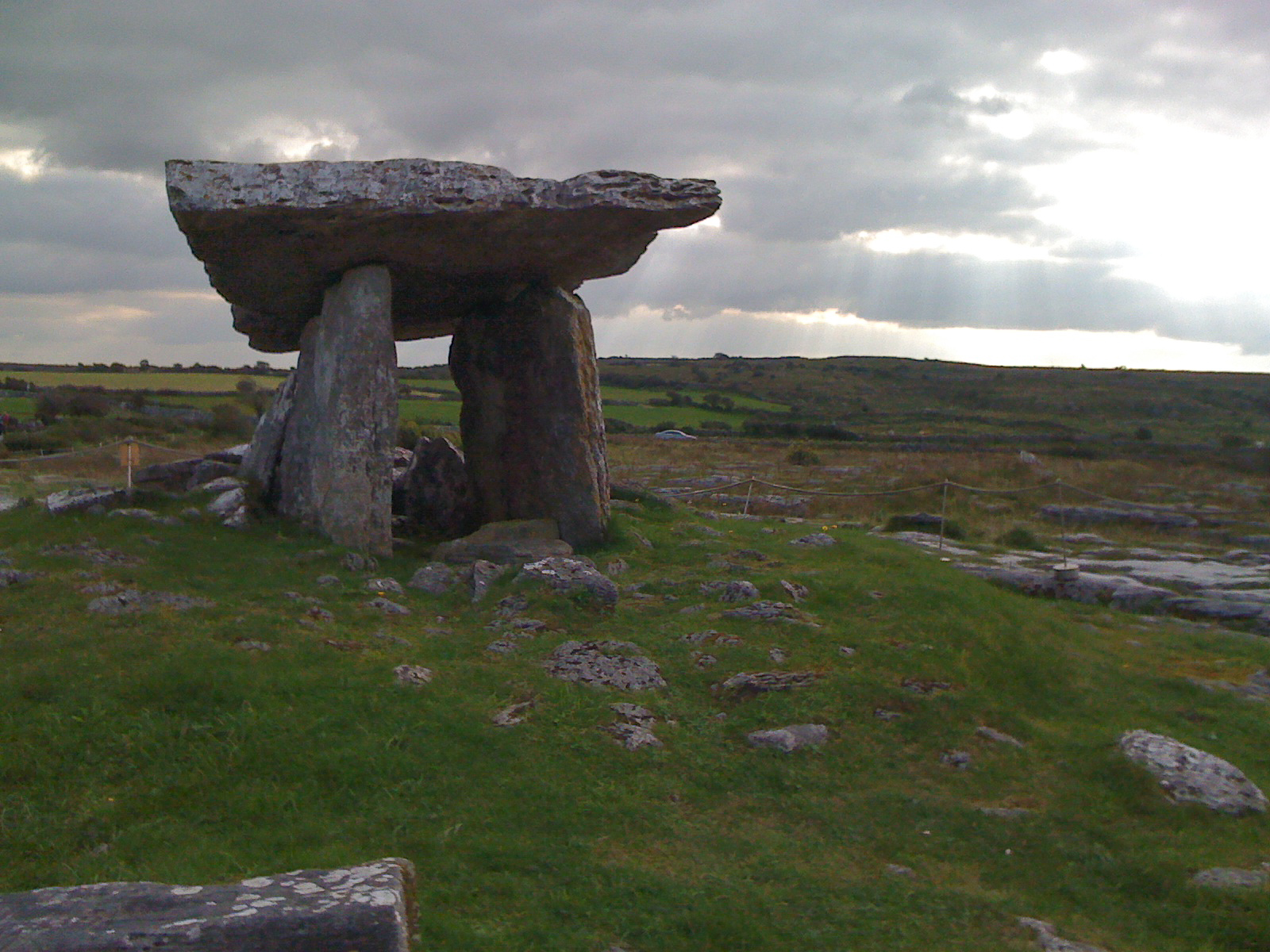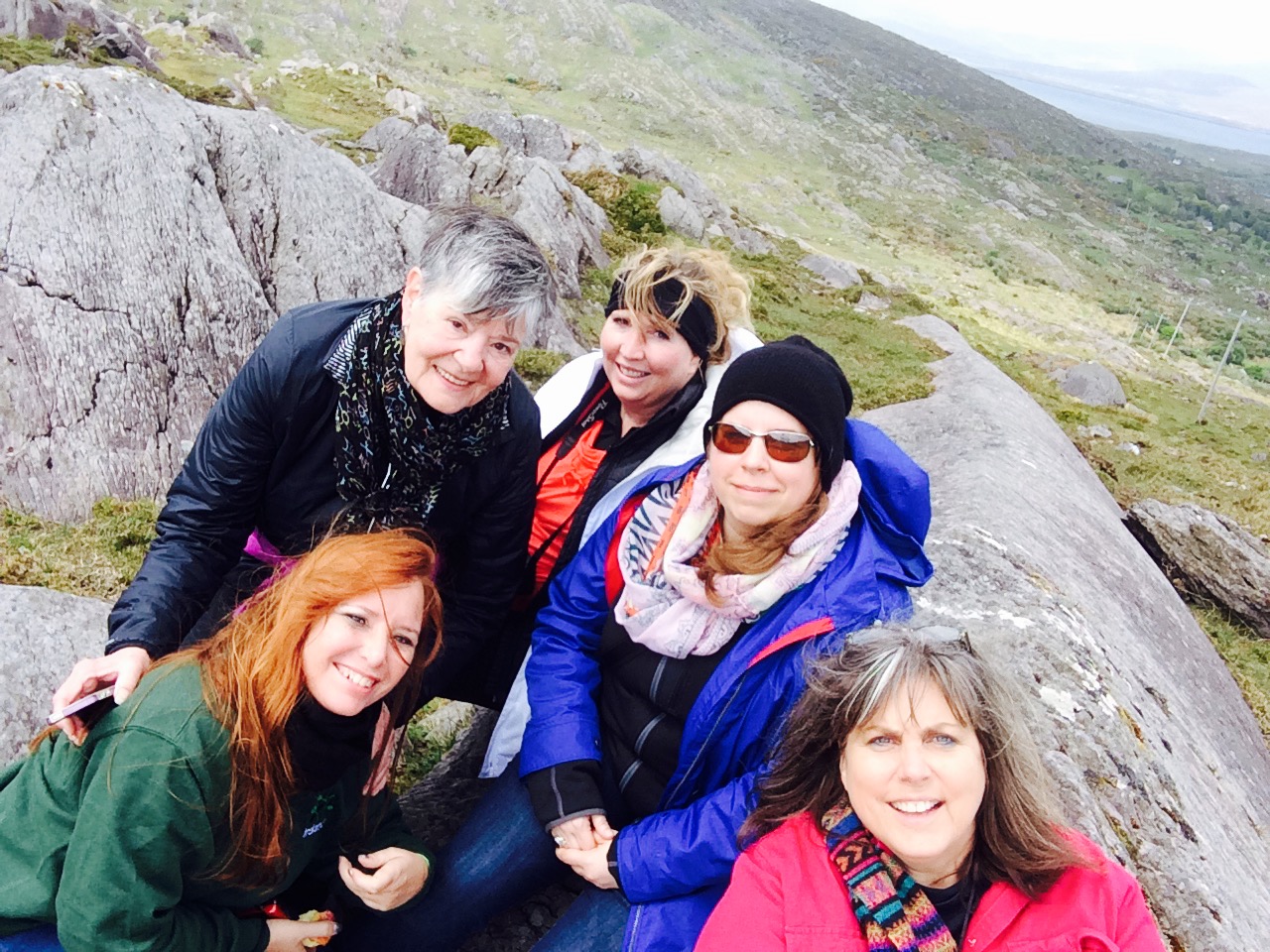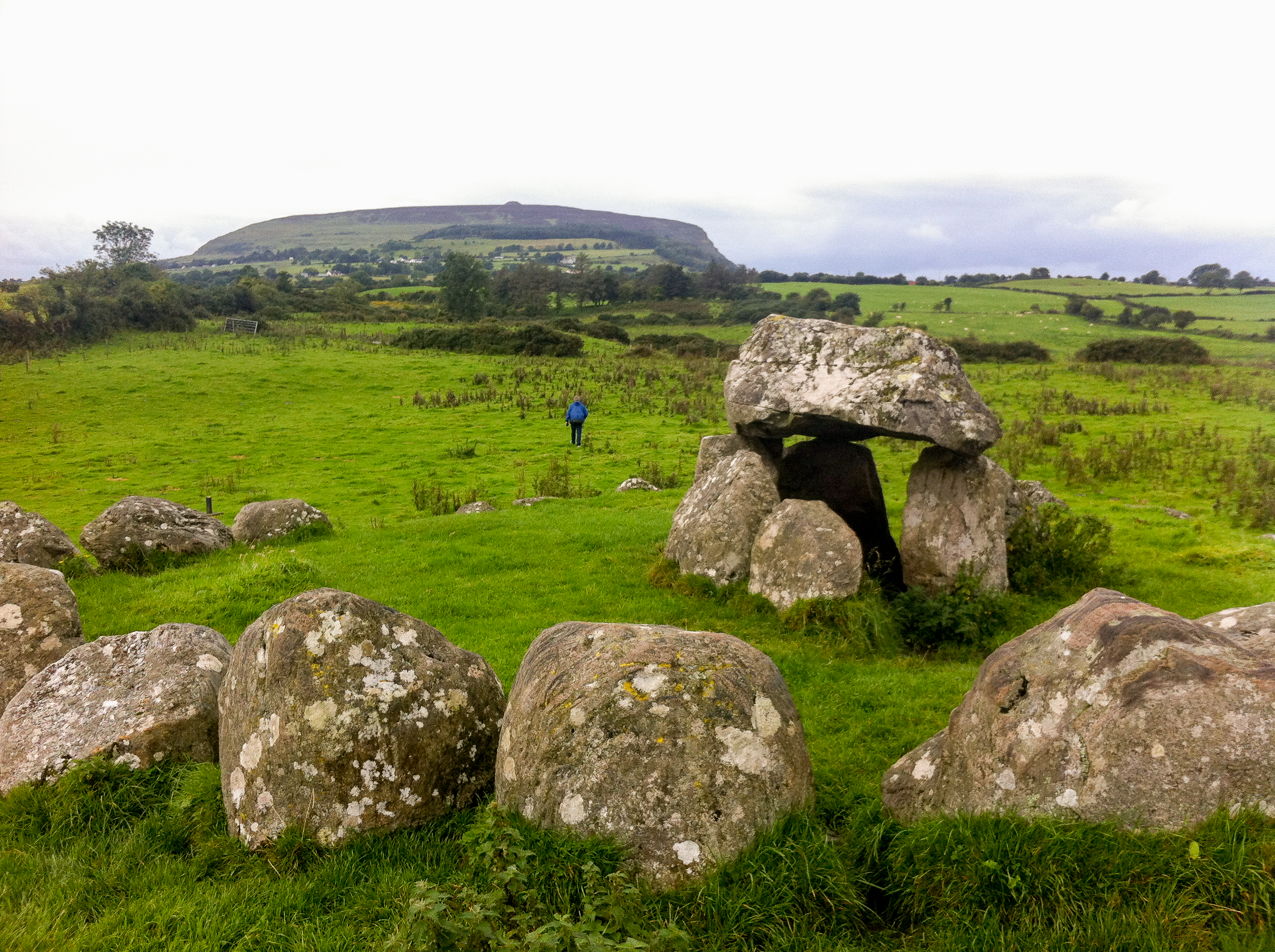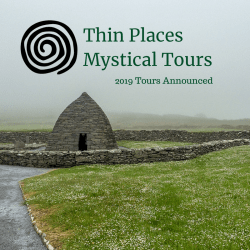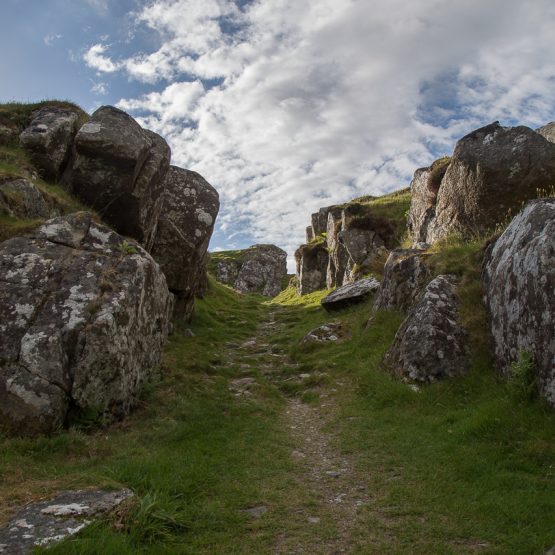A Bridge to the Otherworld – A Rainbow at Beltany
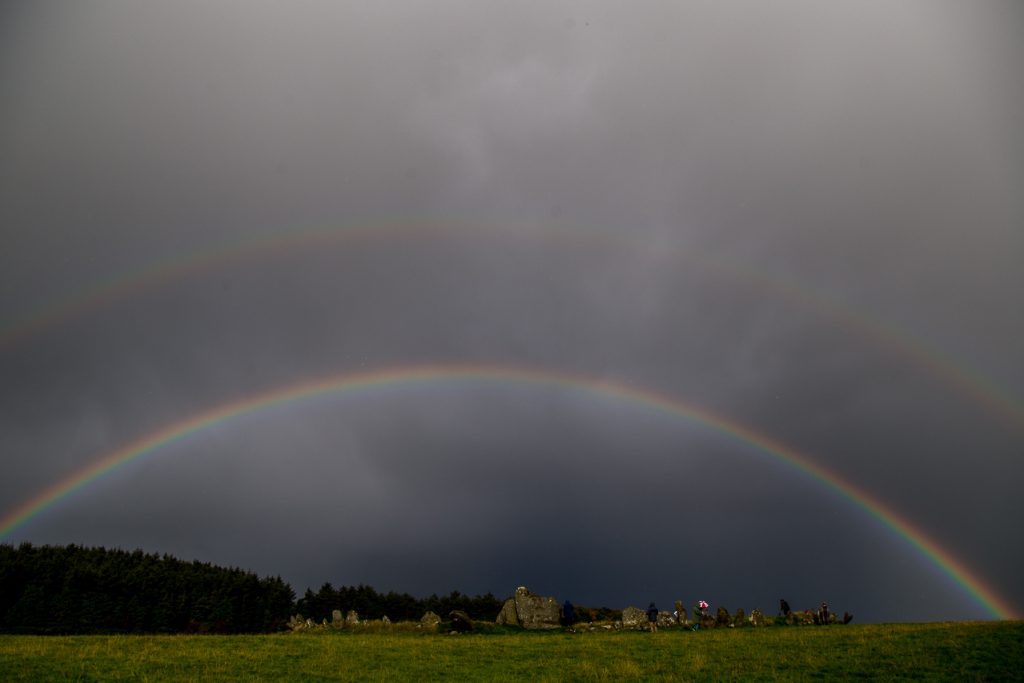
It appeared as if it was a bridge to the Otherworld… the rainbow we saw at Beltany stone circle on the eve of the Autumnal Equinox. The vision was certainly otherworldly. After seeing such a display there’s always the urge to make some kind of sense of it. To find some meaning.
Every culture has its own symbolic meaning for the rainbow. Most traditions focus on connection, a bridge to the otherworld, a promise from God, a sign of hope, a call to follow one’s heart. On the eve of the Autumn Equinox, I led a group up the path to Beltany stone circle in County Donegal. It was wet, rainy and overcast. The field approaching the circle was littered with cow dung. Several of my group turned back finding nothing particularly mystical about Beltany. But for those of us who stayed, the landscape shifted dramatically within fifteen short minutes.
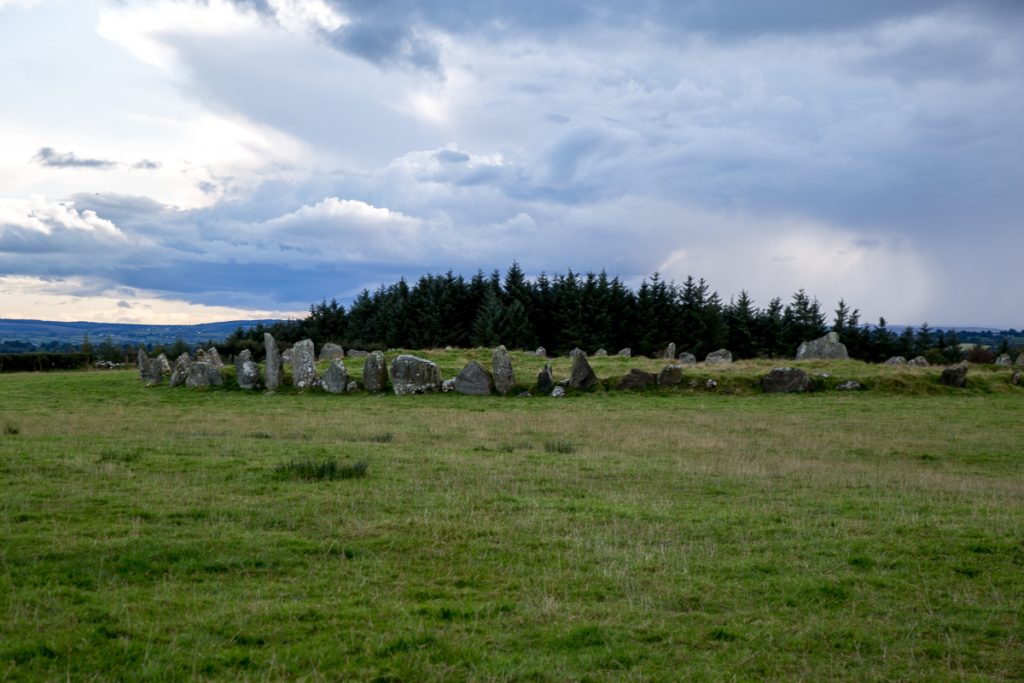
Beltany stone circle dates back to 1400 – 800 BC. With its 64 stones averaging 6 feet in height, it is larger than most found in Ireland. The circle measures about 145 feet in diameter. The site was significantly disrupted during an early twentieth-century excavation leaving the center of the circle lumpy with stones now covered by grass.
Most believe that there were at least 80 stones in the original circle. A wide triangular stone with cup markings immediately draws the eye and stands out from the others (shown to the right in the image above). It faces ENE and stands directly across the circle from the tallest stone (about six feet high) which points WSW. When the two stones align they point to the summit of a hill across the valley. On May 1st – the feast of Bealtaine – that the sun rises over that hill and aligns with these two stones. The circle’s name, “Beltany” likely refers to this celestial event and the feast of Bealtaine.
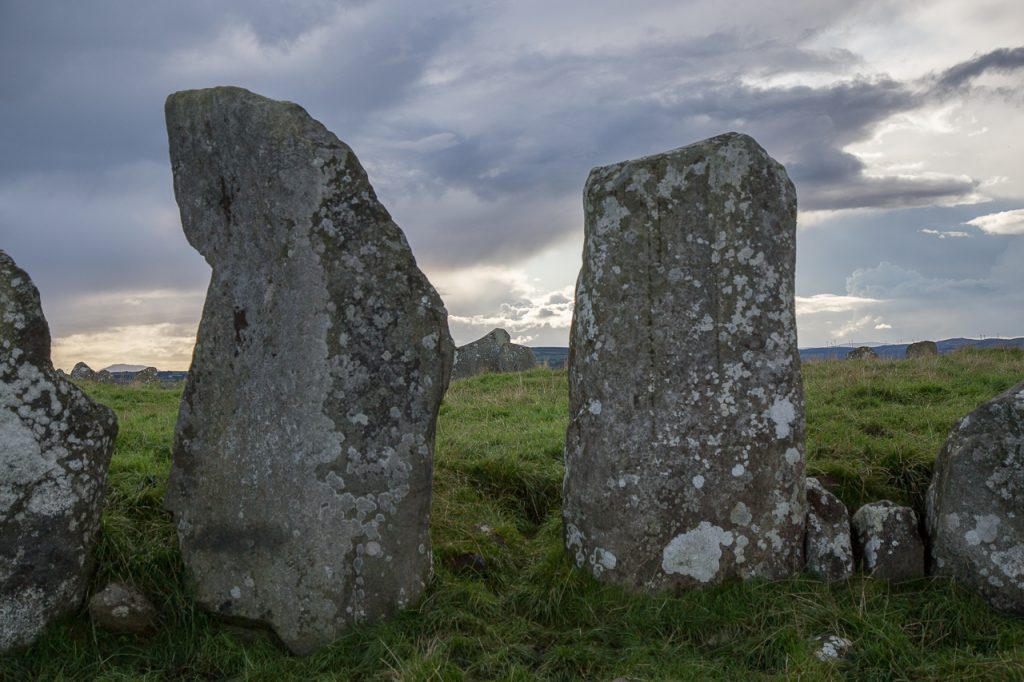
The Rainbow at Beltany
As we walked up the secluded path to the open field where the circle stands, my tour group was tired, the skies were gray and there was a slight drizzle. I was disappointed because I wanted my guest to love the circle as much as I did, but I could see that some of them remained on the bus and others exited quickly due to the difficulty of walking through a wet cattle field. I had only a portion of the tour group at the circle. Then it started to pour.
My heart sank. I want so much for this to be a perfect experience. But sometimes the weather won’t cooperate.
But sometimes the weather and the landscape surprises us.
As the rain softened, I happened to turn around toward the entrance to the field. I saw a pretty vibrant rainbow that was halfway across the sky. I called out to my tour guests to look at it. No one said a word – we just stared.
Then together we watched this rainbow spread perfectly across the sky over the circle. Then a second one appeared over the first. The clarity of the colors was stunning. Then we noticed that there was a darkness or shadow between the two bows. The space between was charcoal colored – different from the sky making the set of rainbows appear to be one thing.
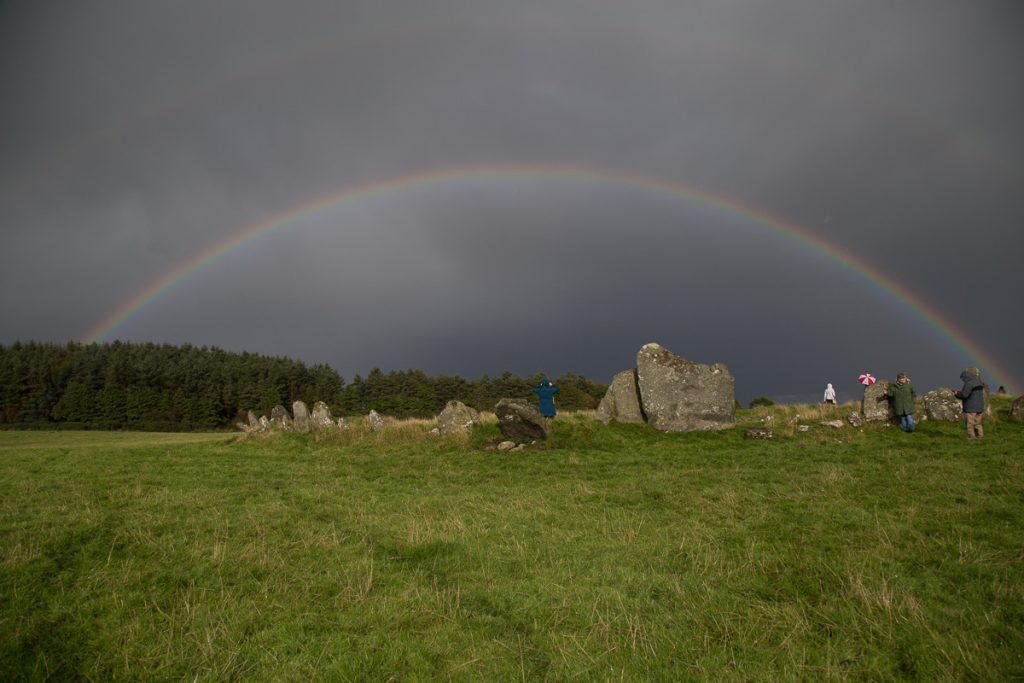
Even the sheep in the field were looking up at the rainbow.
One of my guests said, “In my seventy-one years of life, I have never seen anything like this.” It almost seemed as you could walk out to the end and touch the rainbow. Then the same guest pointed out that the colors were reversed on the second rainbow. Each rainbow was a reflection of the other with the colors going in opposite order – a perfect reflection – a mirror image. Traces of a third rainbow could be seen at the edges of the second.
The Symbolic Meanings of a Rainbow
A rainbow is a fusion of light that projects a harmonious – almost supernatural specter of all the world’s colors visible to the human eye. Every culture in every time has been moved by the sight of the rainbow. It nudges us to find some meaning in the presentation of something so spectacular. The Judeo Christian tradition is rooted in the book of Genesis.
It shall be, when I bring a cloud over the earth, that the rainbow shall be seen in the cloud; and I will remember My covenant which is between Me and you and every living creature of all flesh; the waters shall never again become a flood to destroy all flesh.Genesis 9:14-15
The first nations in North America, as well as many Asian cultures, saw the rainbow as a bridge or passage between the earthly and spirit worlds.
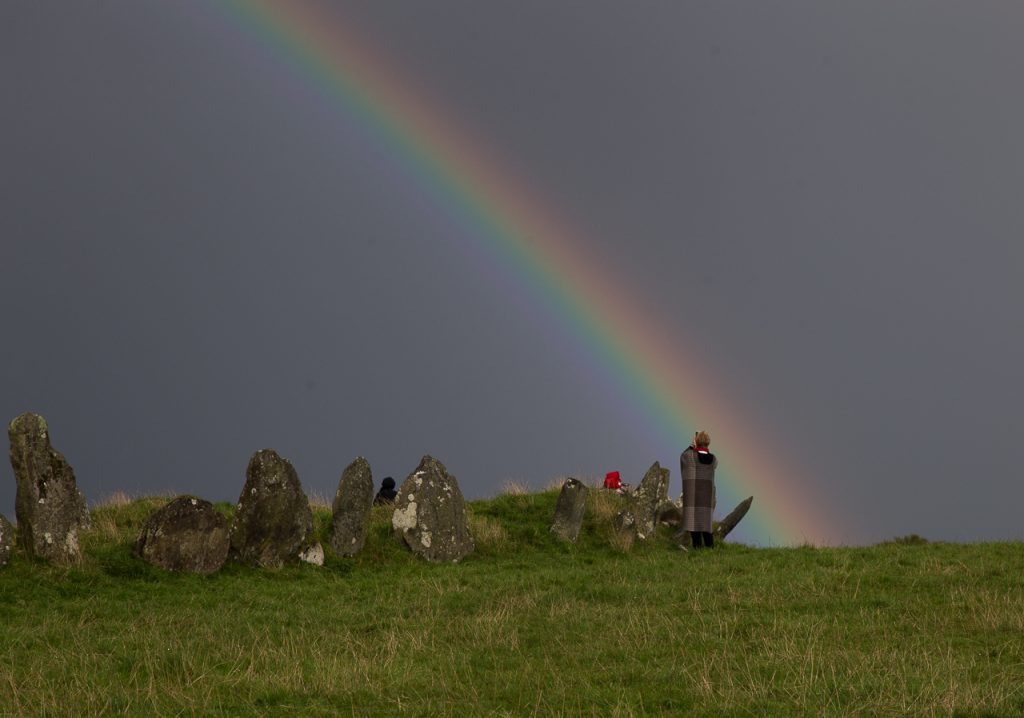
The ancient Irish or pre-Christian Irish saw the rainbow as a sign of blessing – the arc symbolized femininity – the rounded belly about to give birth, which is so appropriate for Beltany because the circle was likely created to celebrate that feast which encourages and blesses fertility and birth. The rainbow was often interpreted as a promise of good luck, abundance a sign to follow the heart’s desire or follow your dreams.
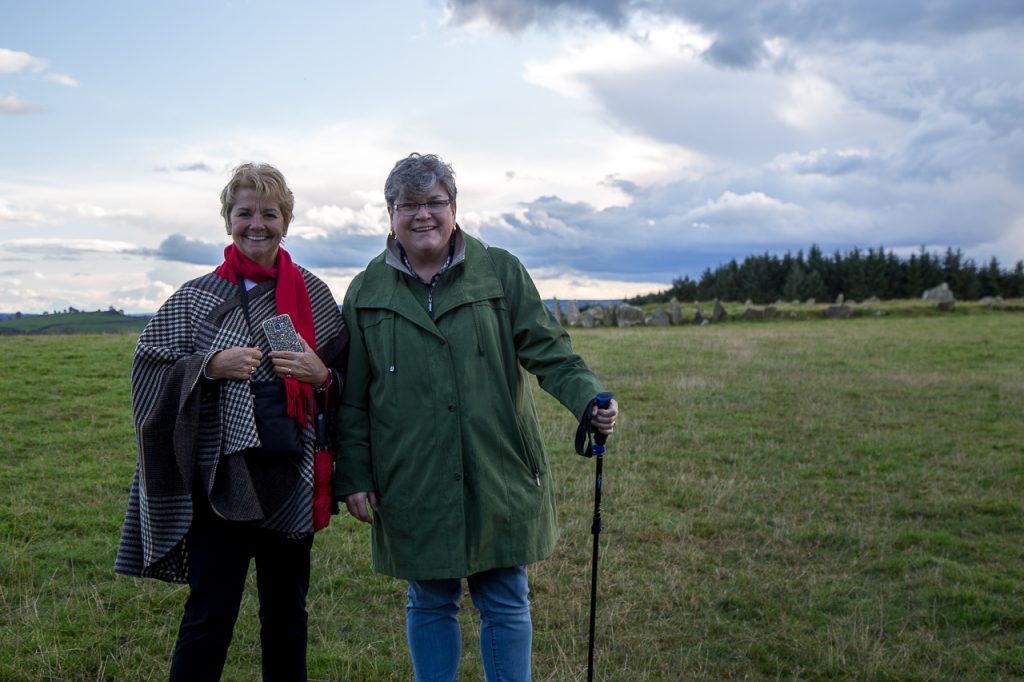
Guests on Discover the North tour after the rainbow
We’ve all heard of the old Irish saying to follow the rainbow and find the “pot of gold.” The rainbow was often interpreted as a promise of good luck, abundance a sign to follow the heart’s desire or follow your dreams. And standing at the edge of that circle and seeing the pulsing vibration of light against the field, one can perceive an actual “physical” end of the rainbow. Almost as if the pot of gold could be within reach. The light is mesmerizing.
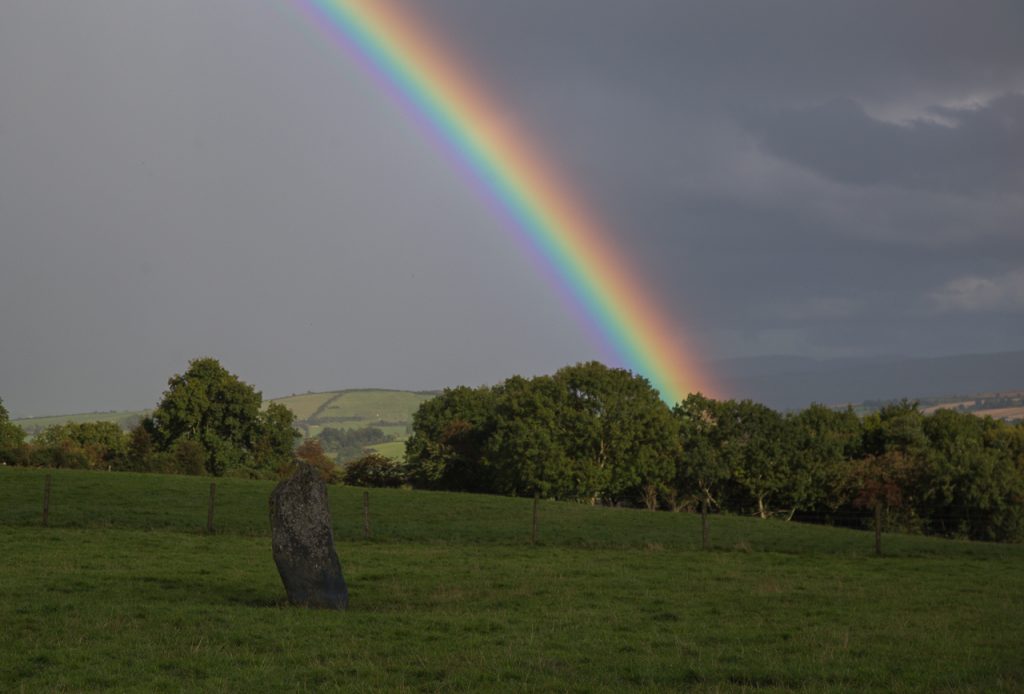
I love the kitschy words of the song from the musical Finian’s Rainbow
Look, look, look to the rainbow
Follow it over the hill and stream.
Look, look, look to the rainbow
Follow the fella’ who follows a dream
In the end, it doesn’t really matter what the rainbow means or doesn’t mean. Just standing in the presence of such a sight was gift enough for me. And it will always be a part of my memories of Beltany.
Walking Meditation at the Hill of Uisneach
The Hill of Uisneach – a Thin Place

Guests at the Catstone on the Hill of Uisneach
The Hill of Uisneach is a thin place – one of those many luminal places in Ireland where the two worlds – physical and eternal – are fused together. It is an ideal site for being spiritually enriched by doing a walking meditation.
Few would realize as they drive along R 390 between Mullingar and Athlone, that they are passing through one of the most mystical places in all of Ireland – the mythological center of Ireland from where an ancient boulder marks the spot where all of the five provinces originate and come together… and beneath that boulder lies the goddess, Ériu, daughter of Ernmas of the Tuatha Dé Danann, earth mother of Ireland – and from whom Ireland takes its name – Eire or Erin.
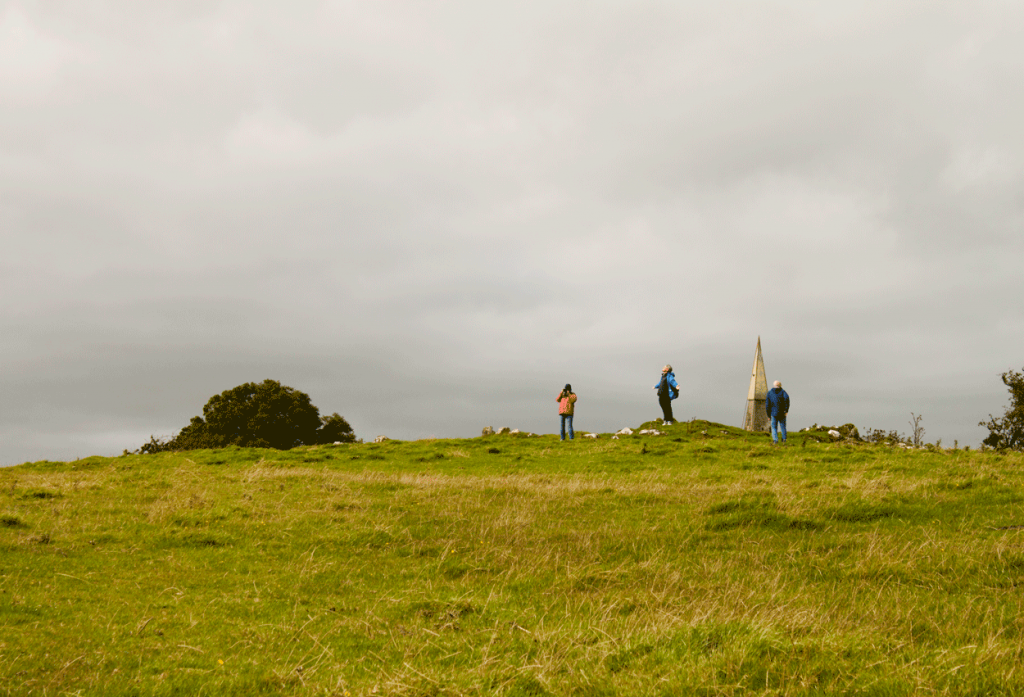
St. Patrick’s Bed on the Hill of Uisneach
From the pinnacle of the Hill of Uisneach, they say a person can see 20 counties. The Irish are always full of superlatives when they describe their archaeological treasures, but I will admit, the views are from that pinnacle – also known as St. Patrick’s Bed – are some of the most stunning I’ve seen in all my travels. The light seems to be different at Uisneach. The energy is riveting on this hill and its surrounds. And moving across this curvy greenscape of Uisneach dotted with stones, brush and lone hawthorn trees, one can see that it is a ripe setting for walking meditation.
Walking Meditation, the Process

Walking on the Hill of Uisneach
I learned about the process of Walking Mediation from my friend – and Brittany expert, Wendy Mewes. She does walking meditations with group tours that come to Brittany. The process that Wendy described is done completely in silence – even in a group. No one talks for the duration of the walk – perhaps 20 minutes.
As the walk begins, one focuses on the act of walking, moving through the landscape, being mindful of the body and the process of walking. Then one becomes mindful of the surrounding life force, noticing it in all living things around…sensing the force.. noticing that every living thing is charged with that divine presence, the presence of the creator – the great spirit – the source of all life and energy.
The third step of the walking meditation is to connect the two – your own life force with that of what surrounds you. What do the trees, the grass, the sky, the stones tell you? What do you hear from them? What do you learn from them? What are you sensing?
Sometimes, when the walking meditation is over, those on the walk discuss the experience and share what they learned, felt, were moved by, etc.
One can become totally consumed in mediation on Uisneach. The energy is overwhelming, and one can lose a sense of time and placement in the physical world. It’s no wonder that the ancients chose this spot for communal, spiritual practices. The Hill and its stories are tied to a tradition of spiritual power, rituals, traditions and mystical occurrences. It is one of Ireland’s most sacred sites.
Uisneach – site of the Bealtaine Fires

The Pinnacle – St. Patrick’s Bed – the Hill of Uisneach – The Bealtaine fires were lit near this site
Uisneach is said to be the spiritual and mythological center of Ireland – the Axis Mundi – Ireland’s naval – the joining point where all of the provinces come together in the center of the country, as well as the joining point between two worlds – the mystical and the physical. Archeological excavations show that Uisneach was likely a fire ritual site – a large one – a place where many people came together and celebrated the feast of Bealtaine.
The Catstone and Enchanted Lake

At the Catstone on the Hill of Uisneach
On the slope of the hill is Uisneach’s most famous landmark. The Aill na Mireann – meaning the stone of divisions, also known as the Catstone (so named because it resembles a crouching cat). This 30-ton limestone boulder that stands 16 feet high sits solitary on the lonely hillside. It was believed to not only mark the intersection of all five of Ireland’s provinces, it’s also said to mark the grave of Ériu, the mother goddess of Ireland, the one whom Ireland – Eire – is named for.
Uisneach was also said to be the site of one of the five great trees of Ireland – The Uisneach Ash – planted by Fintan the Seer who is said to have divided Ireland into its provinces with the stone at the dividing point – calling for there to be knowledge in the west, battle in the north, prosperity in the east and music in the south with royalty in the center. The Stone of Divisions. Since the stone touches every province, it also shares each province’s virtues. Thus we have the concept of all provinces meeting at Uisneach, and it being the mystical and mythological center of Ireland.
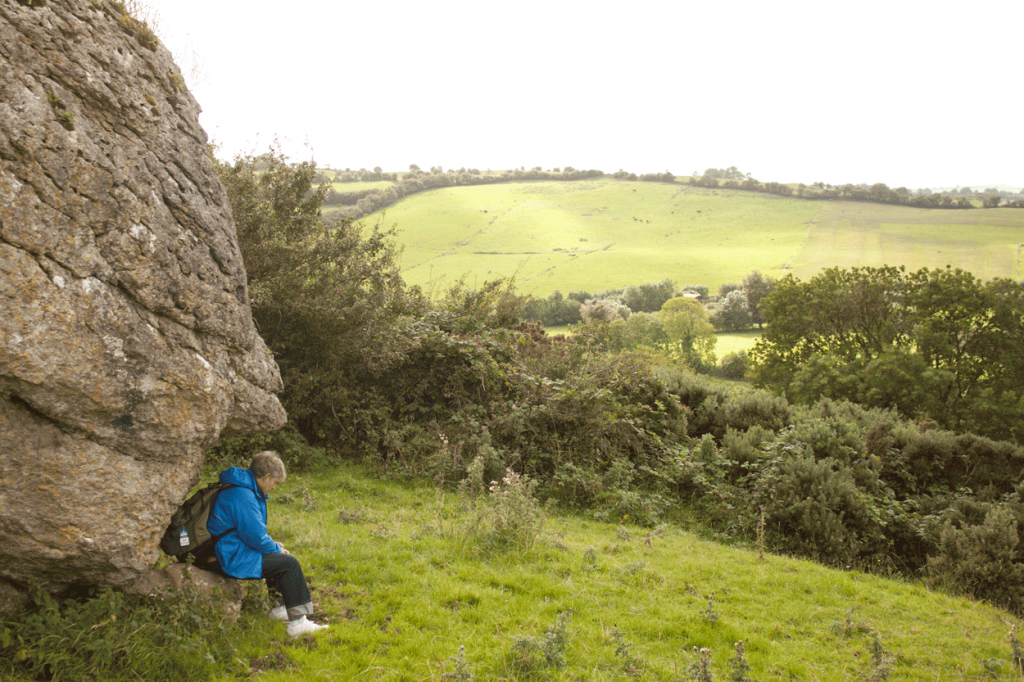
Sitting on the Catstone at the Hill of Uisneach
There have been people tracking ley lines throughout Ireland who see a common pattern with many lines leading to Uisneach. High Kings were once crowned at Uisneach before the Hill of Tara became the royal center for the country. So the legendary mystical character of the site goes back thousands of years.
There is a small (some believe enchanted) lake on the hill dedicated to Lugh, a member of the Tuatha Dé Dannan also known as the sun or harvest god. Legend states that Lugh battled with his brother on this hill and was drowned in the lake and buried under a nearby mound. Some believe the lake is enchanted.

Lugh’s Lake on the Hill of Uisneach
Not too far from Lugh’s Lake is the foundation of the old palace that sat atop the hill. Located in one on those grounds is another stone – nicknamed “the money stone.” It’s short and appears to have petrified wood drilled into it. The stone has amazing energy, and if you place your hand a few inches away from it, you can sometimes feel the energy coming off of it in the form of heat or a vibration. Using dowsing rods on the hill, we found the magnetic pull coming – not from the Catstone, but from the money stone. I’ve not been able to trace the origin of the name of that stone but can encourage people to seek it out.

Under the Fairy Tree – Hill of Uisneach – Images in the Landscape Tour 2015
Considering the ancient fire rituals, royal traditions, legends of the goddess, the Capstone, Money stone and enchanted lake, Uisneach is truly a mythological mecca for those who seek out thin places. A walking meditation here, is powerful food for the spirit.
Images in the Landscape Tour
The Images in the Landscape tour of thin places in the West of Ireland starts in two days, but the complete journey includes the anticipation that comes before travel when we imagine the journey.
So according to that understanding I am already traveling because I’m full of anticipation.
In 2012, I guided a small group of guests on a 10-day thin places tour in the West of Ireland. One of our stops was Coole Park, the home of Lady Augusta Gregory. She and William Butler Yeats and several others were behind much of the Irish Literary Revival in the early twentieth century. Her manor house is gone now, but the grounds, which include formal gardens, a lake and seven woodlands still appear much as they did when she was there overseeing them.
In 1931 Lady Gregory wrote about the grounds around her home:
“These woods have been well loved, well tended by some who came before me, and my affection has been no less than theirs. The generations of trees have been my care, my comforters. Their companionship has often brought me peace.”
As my tour group entered Coole Park, I overheard a park guide addressing a group of tourists. He said, “You have all now just become an image in an ancient landscape.” I thought about the phrase as I continued to walk. Later, that same phrase became a powerful meditation mantra for me.
How many ancient landscapes do we walk through in this life? And how many times are we are reflective enough to connect with them … to become a part of them … to sense the past that swirls around us?
Claiming that Space Between the Inner and Outer Ancient Landscapes
Since that walk in Coole Park three years ago, I’ve led four group tours to Ireland’s thin places, and today I am getting ready to do another, and we’ll be cycling back to Coole Park. The name for this tour is Images in the Landscape. So now …. a phrase dropped by a tour guide in one little slip of a moment will set the tone for the traveling experience of eighteen people.
We will be visiting Coole Park and its ancient landscape that is reminiscent of when Ireland was covered with hardwoods and deep forests, but we’ll also visit the Burren and its sweeping moonscape of rock and megaliths. We’ll journey out into Lough Corrib, a lake named for the mythical Lord of the Sea. And we’ll land on Inchagoil – Lough Corrib’s most famous island. Inchagoil takes its name from the old Irish words for “Island of the stranger” memorializing a devout man who once lived there.
We’ll wind our way through Connemara and absorb that awesome light while following one of Ireland’s most renowned archeologists, Michael Gibbons on a private tour of Connemara’s hidden landscape. Then we’ll head for Crough Patrick – the holy mountain in County Mayo, and the ruins of Murrisk Abbey at the foot of the mountain. We’ll visit Achill Island, sitting atop a bedrock of amethyst. The island radiates a healing energy while it hypnotizes visitors with its scenic coastline. We’ll walk through the Bricklieve mountains and explore a cluster of passage tombs that pre-date the pyramids of Giza. And we’ll stand on the ancient Hill of Uisneach in the mystical center of Ireland and feel the pull of the magnetic energy there.
The Journey Begins with Anticipation
The journey does not begin when we first arrive at the intended destination. It begins with the anticipation of what will come, of what we will see and learn and experience. Part of that is also worry and fear of the unknown. Travel can be unsettling for some. In looking forward to a journey, we wonder who we will meet, what challenges we’ll face, how we’ll feel once we get there and what the pleasant surprises will be. All of the forethought is part of the journey experience.
The first step in travel – we imagine the journey.
The key learning experiences – the crux of the travel story – the high impact part of the journey – the things that change us are all held in the difference between how we imagine the journey and what the journey actually is. Those differences teach us and change us. Our best memories will be embedded in those differences.
I’m Imagining This Journey
Today I imagine meeting sixteen new friends, and I expect I’ll be changed just a little by each one of them. I look forward to walking up the Hill of Uisneach and touching the Cat Stone and surveying six counties from the summit and feeling that sense of coming home. I’m excited about meeting Michael Gibbons and seeing Connemara through his eyes. I imagine all of things he’ll teach us as we walk that ancient landscape with him. I imagine Inchagoil – and its ruins … and the presence that those ruins still cling to. That will be a new site for me.
I also worry. Worrying about travel is also part of the anticipation. Will the guests get along? Will it rain too much? Will the some of the walking be too difficult for our guests – and how will we handle that? Will the hotels have everything in order? Will I remember everything?
The West of Ireland is Magical
Despite my worries, I know that the “Wow!” moments for the guests on this trip will be remarkable. They’ll never forget the Hill of Uisneach. They’ll be stunned by the raw beauty of Achill Island. They’ll learn so much from our three local guides, Tony Kirby, Michael Gibbons and Mike Croghan. And besides that… I believe no one can drive through Connemara and not be changed. It’s like walking through fairy dust. You’re journeying through several worlds there. So I rest a little knowing that the magical western landscape of Ireland in itself is a jewel that embeds itself in every traveler.
I pray for blessings on Terri, Bob, Linda, Gloria, Bev, Lea, Jim, Maril, John, Karen, Ed, Mary, BJ, Meredith, Bonnie and Renee and safe travel. I pray that John, my excellent coach driver and I will be good leaders and sensitive guides and that on September 20th when this tour is over, our imagined journey will be magnified and expanded by our actual journey and that we will all move forward together.


